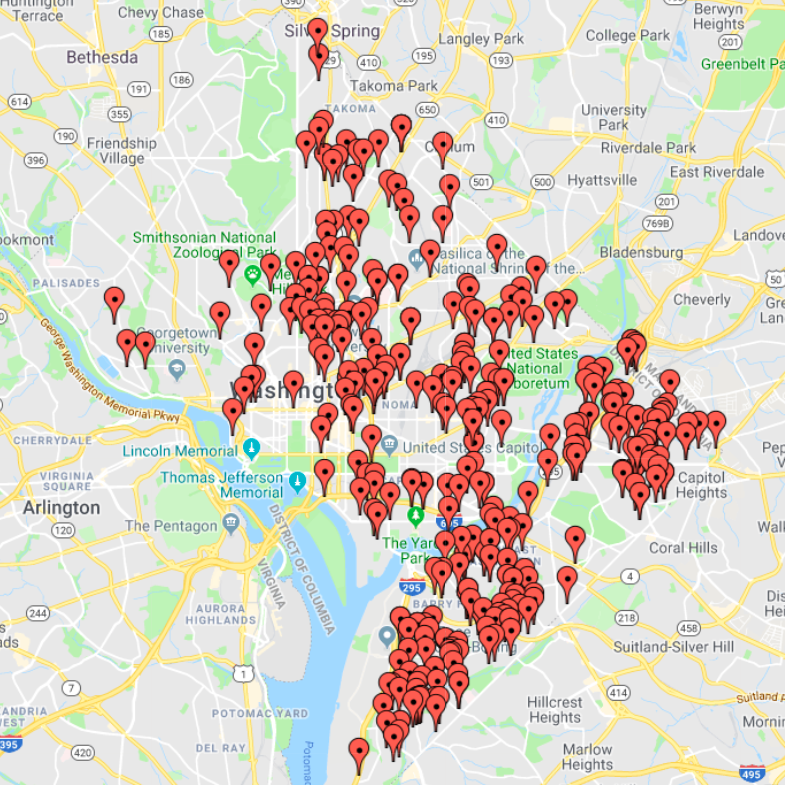
Thank you for reading D.C. Witness. Help us continue our mission into 2024.
Donate NowBy
D.C. Witness Staff
- May 8, 2019
Featured
|
Homicides
|
Infographics
|
Suspects
|
Gun-related homicides are turning out to be more of a problem in Washington, DC than it was two years ago when a Metropolitan Police Department gun recovery program was implemented to curb the violence.
According to D.C. Witness data, there has been a 27 percent increase in gun-related homicides from 2018 to this year. In 2019 as of March 31, there have been 28 gun-related homicides. The data only shows 22 gun-related homicides in 2018 during the same time period. There were 23 gun-related homicides during the first three months in 2017.
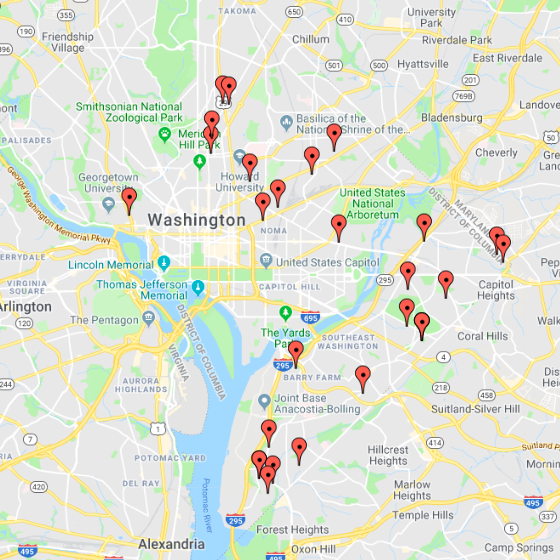
Map of DC shooting homicides that occurred from Jan. 1, 2019 to March 31, 2019.
From January to March, according to a MPD weekly firearms report, police confiscated 448 illegal firearms from throughout the District as seen on the map below.

Map of firearms recovered from Jan. 1 to March 31, 2019.
In total, there were 197 firearms recovered in Southeast DC, 121 from Northeast, 108 from Northwest and 19 from Southwest. Three firearms did not have a reported address.
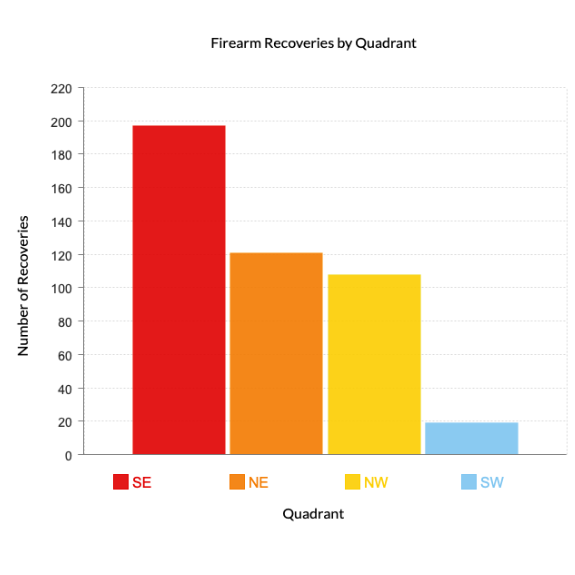 The graph below shows the majority of illegal firearms confiscated in 2019 were recovered from Southeast DC, where the most gun-related homicides, 10, have occurred.
The graph below shows the majority of illegal firearms confiscated in 2019 were recovered from Southeast DC, where the most gun-related homicides, 10, have occurred.
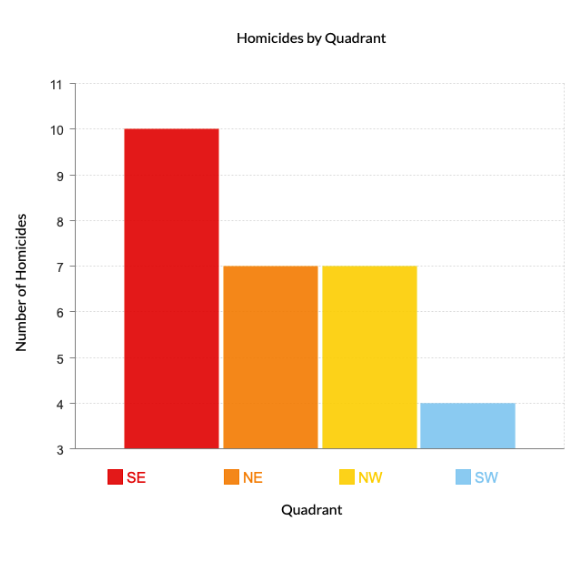 The graph above also shows there were seven gun-related homicides in Northeast, seven in the Northwest and four in Southwest, DC.
The graph above also shows there were seven gun-related homicides in Northeast, seven in the Northwest and four in Southwest, DC.
In comparison to previous years, the Southeast quadrant has consistently had the highest number of gun-related homicides. However, the frequency of gun-related homicides in Southeast DC has dropped over the last two years.
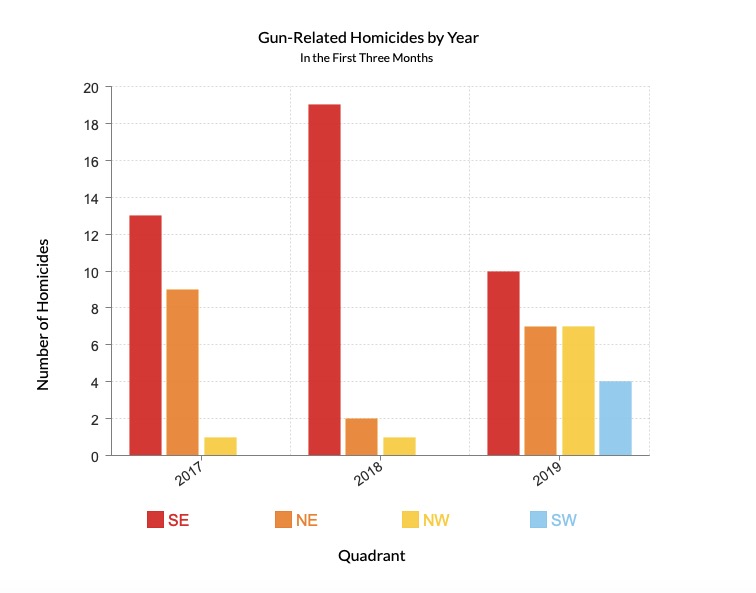
MPD officers have arrested suspects in connection to seven of the 28 shootings that occurred this year. The cases in which arrests have occurred, include:
Michael Taylor was shot on Jan. 12 in an apartment complex on the 1700 block of Benning Road, NE. Alonzo Brown, Stephon Evans and Carlos Turner are currently charged with first-degree murder while armed in connection to the shooting. Court documents state that Taylor, 22, sustained gunshot wounds to the head, left thigh, and left heel.
Brown, 22, Evans, 18, and Turner, 20, are scheduled for a felony status conference on July 2. All three defendants are being held without bail.
On Feb. 26, Tyree Irvingwas arrested and charged with first-degree murder while armed for allegedly shooting 22-year-old Davane Williams on the 1200 block of North Capitol Street, NW on Jan. 15.
Irving, 22, is scheduled for a felony status conference on Aug. 1. His case is still pending a grand jury hearing. Irving is being held without bail.
Elhadji Babacar Ndiaye is charged with first-degree murder while armed for his alleged role in the death of 21-year-old Travis Deyvon Ruth on the 2700 block of Jasper Street, SE on Jan. 18. According to court documents, Ruth was shot nine times.
Ndiaye, 19, is scheduled for a felony status conference on June 21 and is being held without bail.
Roscoe Jones was arrested April 4 for allegedly shooting 33-year-old Mark Mosley on the 600 block of 46th Place, SE on Feb. 24. Jones is charged with first-degree murder while armed. Court documents state that Mosley was found lying face-down with a gunshot wound to the head.
Jones, 23, is scheduled for a felony status conference on June 7. He is also being held without bail.
Jamal Kwame Crump was shot on the 1300 block of Monroe Street, NW on Feb. 27. A 15-year-old juvenile male was charged with first-degree murder while armed and a gun-related offense in connection to the shooting. According to a press-release, Crump, 23, was pronounced dead at a local hospital after sustaining multiple gunshot wounds.
The juvenile is pending trial and scheduled to appear in court on June 5.
Hilman Jordan was arrested and charged with first-degree murder while armed for allegedly shooting 64-year-old Jawaid Bhutto on the 2600 block of Wade Road, SE on March 1. According to court documents, Bhutto was shot once in the chest.
Jordan, 45, is scheduled for a preliminary hearing on May 17 and is being held without bail.
Deontae Britton is charged with first-degree murder while armed for his alleged role in the death of 25-year-old Dawud Debruhl on the 1300 block of Columbia Road, NW on March 14. D.C. Witness previously reported that surveillance footage captured a man walk up behind Debruhl, who was standing in a parking lot with a group of people, and shoot him in the back without “provocation.”
Britton, 25, is scheduled for a preliminary hearing on May 15 and is being held without bail.
No firearm recoveries were reported from any of the arrests made.
According to the MPD, firearms recovered in DC are typically purchased legally in states such as Virginia, Maryland, North Carolina and Georgia. The guns are then brought into the District illegally, meaning they are not registered.
According to the MPD website, conceal and carry licenses are issued in DC as long as a person meets all of the requirements for registering a firearm pursuant to DC law.
The Washington Post reported that illegal guns recovered in the District are “melted down” and ultimately destroyed by law enforcement.
D.C. Witness inquired to MPD about how gun destruction was documented. MPD said the Department of Forensic Sciences (DFS) handles all gun destruction. However, DFS told D.C. Witness that they only handle examination and all firearms are turned back over to MPD for destruction.
According to GunBusters, LLC, an organization that specializes in firearm destruction, illegal firearms are typically confiscated from criminal activity or turned into the police.
GunBusters is licensed by the Bureau of Alcohol, Tobacco, Firearms and Explosives (ATF) and now offers a free nationwide program that thoroughly documents the destruction of all firearms safely and securely.
According to Gus Orr, a GunBusters representative, the organization’s policy requires a recording of the destruction, including each weapon’s serial number and description. The documentation is then handed over to law enforcement.

GunBusters, LLC firearms destruction system.
“We’ve destroyed 37,000 weapons in five years,” Orr said. He said the free service provides hard-copy evidence of destruction and eliminates law enforcement personnel from transporting weapons.
Orr said law enforcement agencies used to destroy guns using methods such as a chop-saw to or a steel-mill incinerator. He said those methods were not only dangerous and time-consuming, but also expensive and inaccurately reported. He said there was a chance the lack of security when using one of the methods could put confiscated guns into someone else’s possession.
In 2019, the free service was made available to law enforcement agencies nationwide. However, Orr said the program is not yet being utilized in the District.
MPD did not respond to D.C. Witness’s inquiries about current firearm destruction methods or programs.
Follow this case